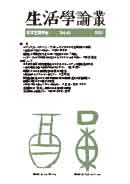40 巻
選択された号の論文の6件中1~6を表示しています
- |<
- <
- 1
- >
- >|
論文
-
2021 年 40 巻 p. 1-14
発行日: 2021年
公開日: 2024/03/31
PDF形式でダウンロード (4902K) -
2021 年 40 巻 p. 15-28
発行日: 2021年
公開日: 2024/03/31
PDF形式でダウンロード (862K)
研究ノート
-
2021 年 40 巻 p. 29-41
発行日: 2021年
公開日: 2024/03/31
PDF形式でダウンロード (1286K) -
2021 年 40 巻 p. 42-53
発行日: 2021年
公開日: 2024/03/31
PDF形式でダウンロード (1918K) -
2021 年 40 巻 p. 54-67
発行日: 2021年
公開日: 2024/03/31
PDF形式でダウンロード (667K) -
2021 年 40 巻 p. 68-79
発行日: 2021年
公開日: 2024/03/31
PDF形式でダウンロード (1383K)
- |<
- <
- 1
- >
- >|
